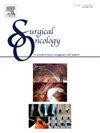The Qaly study: Quality of life and lower extremity lymphedema in 174 patients after inguinal lymphadenectomy
IF 2.4
4区 医学
Q3 ONCOLOGY
引用次数: 0
Abstract
Background
Lower extremity lymphedema (LEL) can develop in patients who undergo inguinal lymph node dissection (ILND) in the treatment of gynecologic, genitourinary, and skin and soft tissue malignancies. While LEL can negatively impact quality of life, the poorly documented prevalence and severity of lymphedema-related symptoms complicates the ability to identify high-risk patients and improve the selection of candidates for emerging microsurgical interventions.
Methods
This multicenter, cross-sectional study included patients who underwent ILND between 1990 and 2022 across three medical centers in the Netherlands. Retrospective clinical data, including demographic, surgical, and postoperative variables, were abstracted from medical records. Lymphedema prevalence and severity were assessed using the Lymph-ICF-LL questionnaire, while additional patient-reported outcome measures (PROMs) evaluated quality of life and lower extremity function. Statistical analyses included multivariate logistic and linear regression to identify predictors of lymphedema-related symptoms and their impact on PROMs.
Results
Among 174 patients who underwent ILND, 77 % reported lymphedema-related symptoms, which were associated with significantly lower quality of life. Multivariable analysis identified that younger age at time of surgery, medical history of cardiovascular disease, and postoperative complications such as surgical site infections (SSI) and prolonged wound healing were significant predictors of developing lymphedema-related symptoms. Additionally, the presence of lymphedema was strongly linked to poorer physical and mental health PROMs, with malignancy type and surgical factors influencing these outcomes.
Conclusion
This study emphasizes the significant burden of lymphedema-related symptoms following ILND, while highlighting the potential role of reconstructive microsurgery in reducing morbidity for high-risk patients.
Qaly研究:174例腹股沟淋巴结切除术后患者的生活质量和下肢淋巴水肿
背景:在妇科、泌尿生殖系统、皮肤和软组织恶性肿瘤的治疗中,接受腹股沟淋巴结清扫(ILND)的患者可发生下肢淋巴水肿(LEL)。虽然LEL会对生活质量产生负面影响,但淋巴水肿相关症状的患病率和严重程度缺乏文献记录,这使得识别高风险患者的能力变得复杂,并改善了新兴显微外科干预措施的候选选择。方法:这项多中心横断面研究纳入了1990年至2022年间在荷兰三家医疗中心接受过ILND的患者。回顾性临床数据,包括人口统计学、手术和术后变量,从医疗记录中提取。使用淋巴- icf - ll问卷评估淋巴水肿的患病率和严重程度,而额外的患者报告的结果测量(PROMs)评估生活质量和下肢功能。统计分析包括多元逻辑和线性回归,以确定淋巴水肿相关症状的预测因子及其对PROMs的影响。结果在174例接受ILND的患者中,77%报告了淋巴水肿相关症状,这与生活质量显著降低相关。多变量分析发现,手术时年龄较小、心血管疾病病史、手术部位感染(SSI)和伤口愈合时间延长等术后并发症是发生淋巴水肿相关症状的重要预测因素。此外,淋巴水肿的存在与较差的身心健康PROMs密切相关,恶性肿瘤类型和手术因素影响这些结果。结论本研究强调了ILND后淋巴水肿相关症状的显著负担,同时强调了重建显微手术在降低高危患者发病率方面的潜在作用。
本文章由计算机程序翻译,如有差异,请以英文原文为准。
求助全文
约1分钟内获得全文
求助全文
来源期刊

Surgical Oncology-Oxford
医学-外科
CiteScore
4.50
自引率
0.00%
发文量
169
审稿时长
38 days
期刊介绍:
Surgical Oncology is a peer reviewed journal publishing review articles that contribute to the advancement of knowledge in surgical oncology and related fields of interest. Articles represent a spectrum of current technology in oncology research as well as those concerning clinical trials, surgical technique, methods of investigation and patient evaluation. Surgical Oncology publishes comprehensive Reviews that examine individual topics in considerable detail, in addition to editorials and commentaries which focus on selected papers. The journal also publishes special issues which explore topics of interest to surgical oncologists in great detail - outlining recent advancements and providing readers with the most up to date information.
 求助内容:
求助内容: 应助结果提醒方式:
应助结果提醒方式:


